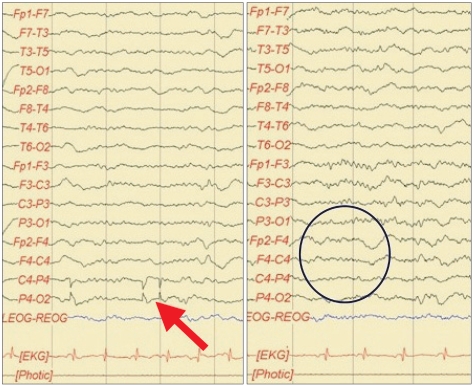Ann Rehabil Med.
2011 Aug;35(4):579-582. 10.5535/arm.2011.35.4.579.
Suppression of Seizure by Cathodal Transcranial Direct Current Stimulation in an Epileptic Patient: A Case Report
- Affiliations
-
- 1Department of Physical Medicine and Rehabilitation, Institute for Medical Sciences, Chonbuk National University Medical School, Research Institute of Clinical Medicine, Chonbuk National University Hospital, Jeonju 561-180, Korea. mhko@jbnu.ac.kr
- 2Department of Pediatrics, Chonbuk National University Hospital, Jeonju 561-180, Korea.
- KMID: 1971727
- DOI: http://doi.org/10.5535/arm.2011.35.4.579
Abstract
- Epilepsy is an intractable disease, though many treatment modalities have been developed. Recently, noninvasive transcranial direct current stimulation (tDCS), which can change brain excitability, was introduced and has been applied for therapeutic purposes regarding epilepsy. A suppression of seizures was experienced by cathodal tDCS in a medication refractory pediatric epileptic patient. The patient was an 11-year-old female who had focal cortical dysplasia of the cerebral hemisphere. The patient was treated with antiepileptic drugs but the mean seizure frequency was still eight episodes per month. The tDCS cathode was placed at the midpoint of P4 and T4 in the 10-20 EEG system where the abnormal wave was observed on a sleep EEG. Two mA of tDCS was applied 20 minutes a day, five days a week for two weeks. During a two-month period after treatment termination, only six seizure attacks occurred, and the duration of each seizure episode also decreased. tDCS was applied under the same conditions for another two weeks. For two months after the second treatment session, only one seizure attack occurred, and it showed great improvement compared to the eight seizure attacks per month before the tDCS treatment. The medications were not changed, and there were no notable side effects that were caused by tDCS.
MeSH Terms
Figure
Reference
-
1. Stafstrom CE. Epilepsy: a review of selected clinical syndromes and advances in basic science. J Cereb Blood Flow Metab. 2006; 26:983–1004. PMID: 16437061.
Article2. Schiller Y, Najjar Y. Quantifying the response to antiepileptic drugs: effect of past treatment history. Neurology. 2008; 70:54–65. PMID: 18166707.
Article3. Spencer S, Huh L. Outcomes of epilepsy surgery in adults and children. Lancet Neurol. 2008; 7:525–537. PMID: 18485316.
Article4. Nitsche MA, Paulus W. Noninvasive brain stimulation protocols in the treatment of epilepsy: current state and perspectives. Neurotherapeutics. 2009; 6:244–250. PMID: 19332316.
Article5. Liebetanz D, Nitsche MA, Tergau F, Paulus W. Pharmacological approach to the mechanisms of transcranial DC-stimulation-induced after-effects of human motor cortex excitability. Brain. 2002; 125:2238–2247. PMID: 12244081.
Article6. Bindman LJ, Lippold OCJ, Redfearn JWT. The action of brief polarizing currents on the cerebral cortex of the rat (1) during current flow and (2) in the production of long-lasting after-effects. J Physiol. 1964; 172:369–382. PMID: 14199369.
Article7. Liebetanz D, Klinker F, Hering D, Koch R, Nitsche MA, Potschka H, Loscher W, Paulus W, Tergau F. Anti convulsant effects of transcranial direct-current stimulation (tDCS) in the rat cortical ramp model of focal epilepsy. Epilepsia. 2006; 47:1216–1224. PMID: 16886986.
- Full Text Links
- Actions
-
Cited
- CITED
-
- Close
- Share
- Similar articles
-
- Transcranial Direct Current Stimulation Combined with Action Observation and Electromyographic Biofeedback Training in a Patient with Writer's Cramp
- Neuromodulation for the Treatment of Tinnitus
- Effects of Dual Transcranial Direct Current Stimulation for Aphasia in Chronic Stroke Patients
- Hypomania Induced by Bifrontal Transcranial Direct Current Stimulation in a Patient with Bipolar Depression
- Non-Invasive Brain Stimulation for Treatment of Focal Hand Dystonia: Update and Future Direction




